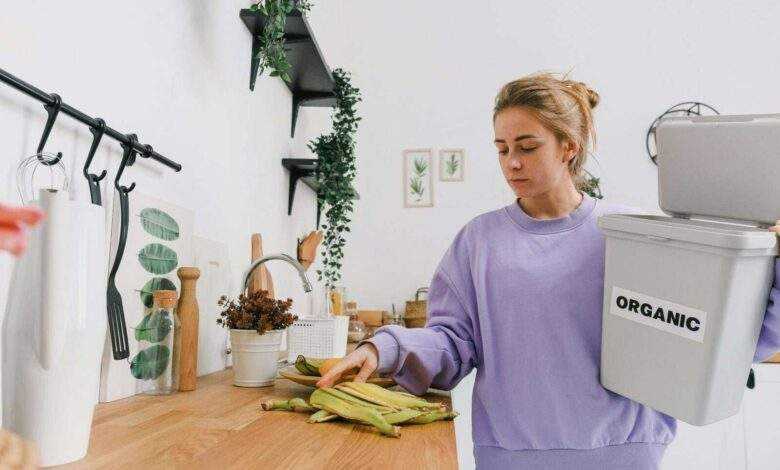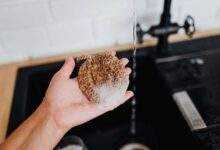Compost Bin DIY: Build Your Own Compost Bin for Kitchen Scraps

Table of Contents
Have you ever gazed upon a overflowing compost bin with a glimmer of hope, wondering if those coffee grounds and eggshells could truly transform into something magical? Well, wonder no more! This comprehensive guide unlocks the secrets of composting, transforming your kitchen scraps into nutrient-rich, “black gold” for a thriving garden.
Composting isn’t just about saving money on fertilizer (although that’s a fantastic perk!). It’s about embracing a sustainable lifestyle, reducing landfill waste, and nurturing the earth with natural goodness. It’s about witnessing a beautiful transformation, as everyday kitchen discards become the fuel for vibrant plant life.
Whether you’re a seasoned gardener or a curious beginner, this guide empowers you to embark on your composting journey. We’ll delve into building your own DIY compost bin, from humble wooden creations to innovative repurposed designs. You’ll learn the art and science of creating a balanced compost pile, ensuring optimal decomposition for that coveted “black gold” everyone dreams of.
From troubleshooting common issues like odors or pests to unleashing the power of compost in your garden, this guide equips you with all the knowledge and inspiration you need to become a composting champion. So, grab that apple core, say goodbye to food waste guilt, and get ready to witness the magic of kitchen alchemy unfold in your own backyard!
Unveiling the Power of Composting
Composting stands as a beacon of sustainable waste management, offering a natural solution to the escalating environmental challenges posed by landfill waste. This section illuminates the profound impact of composting on reducing waste, enhancing soil health, and promoting a greener future.
A. The Looming Landfill Crisis
Landfills loom as vast repositories of our society’s waste, posing significant environmental and health risks. Each year, billions of tons of organic waste, including food scraps, contribute to these mountains of refuse. As these organic materials decompose anaerobically in landfills, they generate methane—a potent greenhouse gas far more impactful than carbon dioxide in the short term. Methane emissions exacerbate climate change, underscoring the urgent need for alternative waste management strategies.
B. The Composting Revolution
Enter composting—a natural process that transforms organic waste into nutrient-rich humus. This process not only mitigates methane emissions by diverting organic materials from landfills but also enriches soils with essential nutrients. Composting capitalizes on microbial decomposition, where bacteria, fungi, and other organisms break down organic matter into humus—a dark, crumbly substance prized for its ability to nourish plants and improve soil structure.
C. A Boon for Your Garden and the Planet
The benefits of compost extend beyond waste reduction to profoundly impact soil health and ecosystem resilience. Compost improves soil structure, enhancing its ability to retain moisture and nutrients critical for plant growth. By fostering healthier plants, compost mitigates the need for synthetic fertilizers, reducing chemical runoff that pollutes waterways and harms aquatic life.
Ecologically, composting represents a proactive step towards mitigating climate change. By diverting organic waste from landfills, composting minimizes methane emissions, thus curbing greenhouse gas contributions. This dual benefit—enhancing soil fertility while reducing environmental impact—positions composting as a cornerstone of sustainable agriculture and urban greening initiatives.
D. Choosing Your Composting Path: Options for Every Home
Embarking on a composting journey begins with selecting the right system tailored to your space, lifestyle, and composting goals. Various composting methods cater to diverse needs:
- Tumbling Composters: Ideal for urban dwellers or those with limited space, tumbling composters facilitate easy turning of compost, accelerating decomposition.
- Stationary Bins: These traditional bins suit larger yards and offer simplicity in compost management, allowing natural decomposition without frequent turning.
- Worm Bins (Vermicomposting): Perfect for indoor composting, worm bins use red worms to process food scraps into nutrient-rich castings suitable for indoor plants or small gardens.
When choosing a composting system, consider factors like available space, desired composting speed, and maintenance requirements. For apartments or confined spaces, compact indoor composting solutions, such as Bokashi systems or worm bins, provide efficient waste reduction without outdoor access requirements.
Building Your DIY Compost Bin Empire
A. The Humble Hero: Crafting a Wooden Compost Bin
Crafting a wooden compost bin is a durable and customizable option for backyard composting. Here’s how you can build one:
Materials Needed:
- 4 pieces of untreated lumber (2×2 or 4×4) for corner posts, 3-4 feet tall
- Cedar or other weather-resistant wood boards (1×6 or 1×8) for the bin walls
- Galvanized screws or nails
- Drill with screwdriver bits
- Saw for cutting wood to size
- Mesh screen or hardware cloth for ventilation (optional)
- Hinges and latch for the access door
Step-by-Step Instructions:
Prepare the Corner Posts:
- Cut the untreated lumber to your desired height (3-4 feet).
- Dig holes in the ground or use post anchors to secure the corner posts firmly.
Construct the Bin Walls:
- Cut the cedar boards to the desired length for each side of the compost bin.
- Attach the boards to the corner posts using screws or nails, leaving gaps between boards for airflow.
Add Ventilation Holes:
- Optionally, staple or screw mesh screen or hardware cloth to the inside walls to improve airflow.
Create the Access Door:
- Cut one board to fit as a door panel.
- Attach hinges to one side of the door panel and the bin frame, allowing it to swing open.
- Use a latch to keep the door closed securely.
Relevant Websites and Resources:
- Mother Earth News – Building a Compost Bin: Offers detailed plans and tips for building various types of compost bins, including wooden designs. Mother Earth News Compost Bin Plans
- Gardeners.com – DIY Compost Bins: Provides step-by-step instructions and video tutorials for building wooden compost bins. Gardeners.com DIY Compost Bins
- The Spruce – How to Build a Wooden Compost Bin: A comprehensive guide with visuals on constructing a wooden compost bin for different gardening needs. The Spruce Wooden Compost Bin Guide
B. Plastic Powerhouse: Transforming a Trash Can into a Compost Bin
Repurposing a plastic trash can is an excellent way to create a simple and effective compost bin. Here’s how you can do it:
Materials Needed:
- Plastic trash can with a lid (choose a size suitable for your composting needs)
- Drill with drill bits
- Mesh screen or hardware cloth
- Bungee cords or straps (optional, for securing the lid)
Step-by-Step Instructions:
Prepare the Trash Can:
- Clean the trash can thoroughly to remove any residual odors or contaminants.
- Drill several small holes in the bottom and sides of the trash can to allow for drainage and airflow.
Create Ventilation:
- Cut a piece of mesh screen or hardware cloth to fit over the top of the compost pile inside the can.
- Place the mesh screen under the lid or cut ventilation holes in the lid itself for proper airflow.
Secure the Lid:
- Use bungee cords or straps to secure the lid firmly in place, ensuring it doesn’t blow away in windy conditions.
Relevant Websites and Resources:
- DIY Network – Trash Can Compost Bin: Provides a simple guide on turning a trash can into a compost bin, suitable for beginners. DIY Network Trash Can Compost Bin
- Planet Natural – Composting 101: Offers tips and resources on composting, including using a trash can as a compost bin. Planet Natural Trash Can Composting
C. Pallet Prowess: Building a Budget-Friendly Compost Bin
Using recycled pallets is a sustainable and cost-effective way to build a compost bin. Here’s how you can create one:
Materials Needed:
- Recycled pallets (choose pallets in good condition without chemical treatments)
- Saw for cutting pallets
- Drill with screws or nails
- Heavy-duty staples or wire for securing pallets
- Hinges and latch for the access door (optional)
Step-by-Step Instructions:
Prepare the Pallets:
- Dismantle the pallets carefully to retrieve usable planks and beams.
- Cut the pallets to the desired size for creating the compost bin structure.
Construct the Bin Frame:
- Use the pallet planks and beams to assemble a three-sided bin structure.
- Secure the corners and sides with screws, nails, or heavy-duty staples.
Secure the Structure:
- Ensure the pallets are securely fastened together to withstand the weight of compost materials.
- Optionally, add hinges and a latch to create an access door for easy compost removal.
Relevant Websites and Resources:
- Eartheasy – DIY Pallet Compost Bin: Offers instructions on building a compost bin from pallets, focusing on sustainability and practicality. Eartheasy DIY Pallet Compost Bin
- Upcycle That – Pallet Compost Bin: Provides creative ideas and step-by-step instructions for repurposing pallets into compost bins. Upcycle That Pallet Compost Bin
Beyond the Basics: Advanced DIY Compost Bin Options
A. The Tumbling Revolution: Creating a Rotating Compost Bin
A rotating compost bin accelerates decomposition through regular turning, providing efficient aeration. Here’s how you can build one:
Benefits of Rotating Compost Bins:
- Faster decomposition due to increased aeration and mixing.
- Easier turning and maintenance compared to traditional bins.
- Ideal for smaller spaces as they often have a compact design.
Materials Needed:
- Large plastic barrel or drum with a lid (food-grade if possible)
- Sturdy metal or wooden stand for mounting the barrel
- Drill with large drill bit
- Strong pipe or rod for the rotating mechanism
- Screws, bolts, and washers for assembly
Step-by-Step Instructions:
Prepare the Barrel:
- Clean and sanitize the barrel thoroughly.
- Drill multiple holes around the sides and bottom of the barrel for aeration.
Create the Mounting Stand:
- Build a sturdy stand using metal or wooden beams to elevate the barrel for easy rotation.
- Ensure the stand provides stability and allows the barrel to rotate freely.
Install the Rotating Mechanism:
- Drill holes through the sides of the barrel near the top.
- Insert a strong pipe or rod through these holes as an axle for the barrel to rotate.
- Secure the axle with bolts and washers on both sides of the barrel.
Use and Maintenance:
- Fill the barrel with compostable materials, ensuring a balanced mix of green and brown materials.
- Rotate the barrel regularly to aerate and mix the compost pile.
- Monitor moisture levels and adjust as needed to optimize decomposition.
Relevant Websites and Resources:
- Gardener’s Supply Rotating Compost Bins
- Offers a selection of rotating compost bin designs and DIY tips.
- Planet Natural DIY Compost Tumbler
- Provides step-by-step instructions and benefits of using a compost tumbler.
B. Worm Wonders: Introducing Worm Composting (Vermicomposting)
Worm composting utilizes worms to break down organic matter into nutrient-rich compost. Here’s how to create a simple worm bin:
Benefits of Vermicomposting:
- Efficient breakdown of kitchen scraps into rich compost (vermicompost).
- Ideal for indoor use as worms thrive in stable indoor temperatures.
- Produces a concentrated, nutrient-rich fertilizer (worm castings) for plants.
Materials Needed:
- Plastic storage bin with a lid (18-24 gallons)
- Drill with small drill bits for ventilation
- Bedding material (shredded newspaper, cardboard, or coconut coir)
- Redworms (Eisenia fetida or Eisenia andrei)
- Kitchen scraps (vegetable and fruit peels, coffee grounds, eggshells)
Step-by-Step Instructions:
Prepare the Bin:
- Drill multiple small holes in the bottom and sides of the bin for drainage and ventilation.
- Layer the bottom with 2-3 inches of moistened bedding material.
Add Worms and Bedding:
- Introduce redworms to the bedding material.
- Cover the worms with additional bedding material to keep them moist and comfortable.
Feed and Maintain:
- Add kitchen scraps in small quantities, burying them under the bedding material.
- Avoid acidic or oily foods, dairy, and meat products.
- Keep the bedding moist but not soggy, and maintain proper aeration by mixing occasionally.
Harvesting Worm Castings:
- Harvest worm castings periodically by moving the finished compost to one side of the bin.
- Use the vermicompost as a potent fertilizer for indoor and outdoor plants.
Relevant Websites and Resources:
- Worm Farming Alliance Vermicomposting Guide
- Offers comprehensive guides and resources on worm composting.
- University of Illinois Worm Composting
- Provides detailed information on setting up and maintaining a worm bin.
C. Indoor Innovation: Crafting a Compact Kitchen Composter
Indoor composting options like Bokashi systems provide efficient waste management solutions for limited spaces. Here’s how to create a countertop compost bin:
Benefits of Indoor Composting:
- Manages food waste conveniently within your home.
- Produces nutrient-rich compost faster than traditional methods.
- Reduces odor and minimizes pest issues associated with outdoor composting.
Materials Needed:
- Airtight container with a lid (2-5 gallons)
- Bokashi bran or compost starter
- Kitchen scraps (including meat and dairy)
- Ventilation system (optional)
Step-by-Step Instructions:
Prepare the Container:
- Clean and sanitize the airtight container with a lid.
- Drill small ventilation holes if needed, ensuring they are covered with a mesh screen.
Layer with Bokashi Bran:
- Spread a layer of Bokashi bran or compost starter on the bottom of the container.
- Add a thin layer of kitchen scraps, covering them evenly with more Bokashi bran.
Repeat the Process:
- Continue adding layers of kitchen scraps and Bokashi bran until the container is full.
- Press down the contents to remove air and ensure they are compact.
Fermentation Process:
- Seal the lid tightly after each addition to maintain an anaerobic environment.
- Store the container in a cool, dark place and allow the contents to ferment for 2-4 weeks.
Composting the Bokashi Pre-compost:
- Dig a hole in your garden or add the pre-compost to an outdoor compost bin.
- Cover the pre-compost with soil and allow it to further break down before using it in your garden.
Relevant Websites and Resources:
- Bokashi Living Getting Started
- Provides detailed guides and products for starting with Bokashi composting.
- Eco-Bin Indoor Composting Solutions
- Offers various indoor composting solutions and tips for urban dwellers.
The Art and Science of Composting
A. The “Brown” and the “Green”: Understanding Carbon and Nitrogen Levels
Achieving a balanced compost pile involves understanding the carbon-to-nitrogen ratio and using appropriate materials:
Introduction to Carbon and Nitrogen:
Composting relies on a balance of carbon-rich “brown” materials and nitrogen-rich “green” materials. This balance fuels microbial activity, speeding up decomposition and producing nutrient-rich compost for your garden.
Examples of Common Materials:
- Green Materials: Fruit and vegetable scraps, coffee grounds, grass clippings.
- Brown Materials: Dry leaves, straw, shredded paper, sawdust.
Maintaining the Ideal Ratio:
The optimal carbon-to-nitrogen ratio (C:N ratio) for composting is around 30:1. This ratio ensures efficient decomposition without excess nitrogen (which can lead to odor issues) or excess carbon (slowing decomposition).
Tips for Adjusting the Ratio:
Adjust the C:N ratio by adding more brown materials to increase carbon or more green materials to increase nitrogen, depending on your compost pile’s conditions.
Relevant Websites and Resources:
- Cornell Waste Management Institute
- Offers detailed information on composting science, including carbon-to-nitrogen ratios and material selection.
- EPA Composting at Home
- Provides guidelines on composting basics and material selection for home composting.
B. The Recipe for Success: Layering Your Compost Pile
Layering your compost pile properly ensures efficient decomposition and nutrient retention:
Step-by-Step Layering Guide:
- Bottom Layer (Brown Materials):
Start with a layer of brown materials such as dry leaves or shredded paper. This layer provides structure and helps with drainage. - Middle Layer (Green Materials):
Add a layer of green materials like kitchen scraps or grass clippings. Chop or shred larger pieces to accelerate breakdown and promote microbial activity. - Alternate Layers:
Continue alternating brown and green layers to maintain balance. Aim for layers that are 2-4 inches thick to optimize decomposition.
Importance of Chopping/Shredding:
Chopping or shredding materials like branches or large leaves increases surface area, speeding up decomposition and preventing matting.
Maintaining Moisture Levels:
Ensure the compost pile is as moist as a wrung-out sponge. Water layers as needed, especially during dry periods, to maintain decomposition efficiency.
Relevant Websites and Resources:
- Rodale Institute Composting Guide
- Provides organic gardening resources including composting techniques and tips.
- USDA Natural Resources Conservation Service
- Offers guides on soil health management, including composting practices.
C. The Turning Point: Maintaining Your Compost Pile
Regular turning of your compost pile is crucial for proper aeration and decomposition:
Importance of Turning:
Turning the compost pile introduces oxygen, which speeds up decomposition and prevents anaerobic conditions. This aeration also helps control odors.
Turning Techniques:
Use a pitchfork or compost turning tool to aerate the pile thoroughly. Turn the pile once a week to maintain optimal conditions for decomposition.
Monitoring with a Thermometer:
Use a compost thermometer to monitor internal temperatures regularly. Temperatures between 110-160°F indicate active decomposition.
Relevant Websites and Resources:
- Gardeners Supply Composting Tips
- Provides tools, tips, and accessories for composting enthusiasts.
- Compost Instructions
- Offers comprehensive guides and troubleshooting tips for composting at home.
Troubleshooting Your Compost Pile: Conquering Common Challenges
Composting can encounter various challenges that may hinder its effectiveness. Addressing these issues promptly ensures a successful composting process.
A. The Odory Odyssey: Eliminating Unpleasant Smells
Unpleasant odors in a compost bin can stem from several factors, including an imbalance of materials, inadequate aeration, or improper moisture levels.
Causes of Odors:
- Imbalance of Materials: Compost piles require a balance between nitrogen-rich (green) and carbon-rich (brown) materials. Too much nitrogen can lead to strong ammonia-like odors.
- Lack of Aeration: Insufficient oxygen in the compost pile creates anaerobic conditions where odorous gases like hydrogen sulfide form.
- Moisture Issues: Excess moisture can cause anaerobic decomposition and foul odors.
Solutions:
- Adjust Carbon-to-Nitrogen Ratio: Increase the amount of brown materials (carbon-rich), such as dried leaves, straw, or shredded paper, to balance out excess nitrogen. Aim for a carbon-to-nitrogen ratio of approximately 30:1.
- Increase Aeration: Turn the compost pile more frequently using a pitchfork or compost turning tool to introduce oxygen. This encourages aerobic decomposition, reducing odors.
- Manage Moisture Levels: Ensure the compost pile is as moist as a wrung-out sponge. Cover the pile during rain and add dry materials like shredded newspaper or cardboard to absorb excess moisture.
- Use Odor-Masking Materials: Incorporate coffee grounds, citrus peels, or herbs like mint into the compost. These materials not only mask odors but also add beneficial nutrients to the compost.
Relevant Websites and Resources:
- Compost Coalition Odor Control
- Offers tips on managing compost odors and achieving a balanced compost pile.
- Planet Natural Compost Troubleshooting
- Provides troubleshooting guides for common composting problems, including odor control and management.
B. The Pest Patrol: Keeping Unwanted Critters at Bay
Compost piles can attract pests such as fruit flies and rodents, which can disrupt the composting process and pose hygiene concerns.
Common Pests:
- Fruit Flies: Attracted to decaying fruit and vegetable scraps in the compost pile.
- Rodents: Attracted to food scraps and warm, undisturbed compost piles.
Preventative Measures:
- Properly Sealed Lid: Use a tightly sealed lid on your compost bin or pile to prevent pests from entering. Ensure there are no gaps or openings.
- Maintain Balance: Keep a balanced mix of materials in the compost pile to minimize odors that attract pests. Avoid adding meat scraps, dairy products, or oily foods that can attract rodents.
- Natural Pest Deterrents: Plant aromatic herbs like lavender, rosemary, or basil around the composting area to naturally repel pests.
- Compost Pile Location: Place your compost bin in a well-lit area with good airflow to discourage pests from making a home in the pile.
Managing Existing Pest Problems:
- Biological Controls: Introduce beneficial nematodes or predatory insects that feed on pests without harming the compost or garden plants.
- Physical Barriers: Use wire mesh or hardware cloth at the base of your compost bin to prevent rodents from burrowing into the pile.
Relevant Websites and Resources:
- University of Illinois Extension Pest Management
- Provides information on integrated pest management strategies for home composting, including natural pest control methods.
- Gardening Know How Pest Control
- Offers tips on natural pest control methods suitable for composting environments.
C. The Slow and Steady Wins the Race: Understanding Decomposition Time
The decomposition rate of compost can vary based on environmental factors and the types of materials used.
Factors Affecting Decomposition:
- Material Size: Smaller pieces decompose faster due to increased surface area and exposure to microorganisms.
- Moisture Levels: Optimal moisture levels (50-60%) support microbial activity and decomposition. Too much moisture can lead to anaerobic conditions.
- Temperature: Warmer temperatures accelerate microbial activity and decomposition rates.
General Timeframe for Compost Maturity:
- Typically 3-6 Months: Under ideal conditions, compost can mature within this timeframe. Factors such as turning frequency and material type can influence this.
Signs of Finished Compost:
- Texture: Finished compost should have a dark, crumbly texture that resembles rich, fertile soil.
- Appearance: It should be free of recognizable materials and have an earthy smell.
Relevant Websites and Resources:
- Texas A&M AgriLife Extension Compost Maturity
- Provides insights into compost maturity and readiness for use in gardens, including factors affecting decomposition.
- Compost Guide Decomposition Factors
- Offers detailed explanations on factors influencing compost decomposition and maturation.
Unleashing the Power of Compost: Utilizing Your Garden Gold
Compost is a gardener’s best friend, enriching soil, enhancing plant growth, and promoting overall garden health through various applications.
A. The Secret Weapon: Amending Soil with Compost
Adding compost to garden soil is essential for improving soil structure, enhancing nutrient availability, and fostering healthy plant growth.
Benefits of Adding Compost:
- Improved Soil Structure: Compost helps loosen clay soils and improve water infiltration and root penetration in sandy soils.
- Nutrient Enrichment: Provides essential nutrients like nitrogen, phosphorus, potassium, and micronutrients crucial for plant growth.
- Enhanced Water Retention: Increases soil’s water-holding capacity, reducing water runoff and improving drought resistance.
- Microbial Activity: Introduces beneficial microbes that aid in nutrient cycling and disease suppression.
Incorporating Compost:
- Planting Beds: Mix compost thoroughly into planting beds before planting to improve soil fertility and structure.
- Existing Gardens: Apply compost as a top dressing around existing plants to replenish nutrients and improve soil health.
- Direct Application: Spread compost around plants’ root zones without digging to minimize root disturbance.
Tips on Application:
- Soil Type: Adjust the amount of compost based on soil type—add more to sandy soils for better water retention and less to clay soils for improved drainage.
- Plant Needs: Tailor compost application to specific plant requirements—leafy greens and vegetables benefit from nutrient-rich soil, while some native plants prefer less nutrient-rich environments.
Relevant Websites and Resources:
- Gardening Know How – Using Compost in the Garden
- Provides comprehensive guidance on using compost to improve garden soil and enhance plant health.
- Rodale Institute – Benefits of Composting
- Offers research-based insights into the benefits of compost for soil health and plant nutrition.
B. The Mulch Master: Using Compost for Top Dressing
Compost serves as an effective mulch to conserve soil moisture, suppress weeds, and moderate soil temperatures, providing multiple benefits beyond traditional mulching materials.
Benefits of Compost Mulch:
- Moisture Retention: Acts as a sponge, retaining moisture and reducing water evaporation from the soil surface.
- Weed Suppression: Smothers weeds by blocking sunlight and providing a barrier to weed growth.
- Soil Temperature Regulation: Insulates soil, keeping it cooler in summer and warmer in winter, promoting ideal plant root growth.
Applying Compost Mulch:
- Application Technique: Spread compost evenly around plants, maintaining a layer thickness of 1-2 inches to avoid smothering plant roots.
- Renewal: Reapply compost mulch annually or as needed to maintain its effectiveness and replenish soil nutrients.
Advantages Over Traditional Mulches:
- Nutrient-Rich: Unlike wood chips or straw, compost continuously enriches soil as it decomposes, providing ongoing benefits to plants.
- Environmental Benefits: Reduces the need for synthetic fertilizers and chemical weed control methods, supporting sustainable gardening practices.
Relevant Websites and Resources:
- Mother Earth News – Using Compost as Mulch
- Discusses various benefits and methods of using compost as a mulch in organic gardening.
- Fine Gardening – Compost as Mulch
- Provides practical tips and techniques for using compost effectively as a mulch in gardens.
C. The Seed Starter Supreme: Creating a Nutrient-Rich Seed Starting Mix
Using compost in seed starting mixes enhances seed germination, promotes healthy seedling growth, and reduces the need for synthetic fertilizers.
Benefits of Compost in Seed Starting:
- Nutrient Supply: Provides essential nutrients and beneficial microbes that support strong seedling development.
- Moisture Retention: Maintains consistent moisture levels critical for seed germination and early seedling growth.
- Microbial Activity: Introduces beneficial microbes that protect seedlings from diseases and improve nutrient uptake.
Creating a Seed Starting Mix:
- Recipe: Combine compost with equal parts sand, perlite, or coconut coir to create a well-draining, nutrient-rich seed starting medium.
- Application: Fill seedling trays or pots with the compost mix, sow seeds according to package instructions, and water gently.
Advantages Over Traditional Potting Mixes:
- Cost-Effective: Reduces the need for commercial potting mixes, saving money while providing superior nutrient content.
- Environmental Impact: Supports sustainable gardening practices by reducing reliance on synthetic fertilizers and peat-based mixes.
Relevant Websites and Resources:
- University of Minnesota Extension – Seed Starting with Compost
- Offers guidelines on using compost in seed starting mixes for optimal plant growth and development.
- The Spruce – Using Compost in Seed Starting
- Provides practical tips and techniques for incorporating compost into seed starting mixes for successful gardening outcomes.
Sharing the Composting Love: Spreading Awareness and Sustainability
Composting is not just a personal endeavor but a community-driven initiative that can have far-reaching benefits for neighborhoods and beyond.
Promoting Community Composting Efforts
Community Composting Programs: Encourage participation in local community composting initiatives where neighbors can collectively manage organic waste. These programs often provide shared compost bins or designated drop-off locations for residents to contribute their kitchen scraps and yard waste.
Neighborhood Initiatives: Highlight the advantages of organizing neighborhood composting groups where participants can share resources, knowledge, and the resulting compost. This fosters a sense of community while reducing individual waste contributions and promoting sustainable practices.
Environmental Impact: By diverting organic waste from landfills through community composting efforts, neighborhoods can significantly reduce methane emissions and contribute to healthier soil for local gardens and green spaces.
Sharing Composting Knowledge and Resources
Educational Workshops: Encourage readers to host or attend composting workshops within their communities. These workshops can cover topics such as basic composting techniques, troubleshooting common issues, and the benefits of compost use in gardens.
Online Platforms: Utilize social media platforms and community forums to share composting tips, success stories, and resources with friends, family, and neighbors. This digital outreach can inspire others to start composting and foster a broader discussion on sustainable waste management practices.
Advocating for Composting Initiatives
Community Engagement: Advocate for the expansion of composting programs in local municipalities by reaching out to city officials, attending public meetings, and joining environmental advocacy groups. Highlight the environmental, economic, and social benefits of composting to garner support for policy changes and infrastructure improvements.
Relevant Websites and Resources:
- Community Composting Council
- Provides resources and guidance for starting and managing community composting programs.
- ShareWaste
- Connects people who have organic waste with their neighbors who are composting, promoting community sharing and waste reduction.
- EPA – Composting at Home
- Offers information on composting benefits, methods, and resources to encourage community composting initiatives.
Resources for Your Composting Journey
Embark on your composting journey with these valuable resources that offer guidance, support, and inspiration:
Government Websites and Environmental Organizations
- Environmental Protection Agency (EPA) – Composting at Home: Offers comprehensive guides, tips, and benefits of composting. EPA Composting at Home
- USDA Natural Resources Conservation Service (NRCS) – Soil Health: Provides information on composting’s role in soil health and conservation. NRCS Soil Health
Online Communities and Forums
- Reddit – r/composting: A community of composting enthusiasts sharing tips, troubleshooting advice, and success stories. r/composting
- GardenWeb Forums – Compost Forum: Active discussions on composting methods, DIY bin construction, and compost use in gardening. GardenWeb Compost Forum
YouTube Channels and Tutorials
- Garden Answer: Offers practical tutorials on composting techniques, including bin construction and troubleshooting. Garden Answer – Composting Playlist
- Epic Gardening: Features videos on composting basics, advanced techniques, and using compost in gardening. Epic Gardening – Composting
Composting Books and Publications
- “Let It Rot! The Gardener’s Guide to Composting” by Stu Campbell: A popular guide covering composting basics, troubleshooting, and advanced techniques.
- “The Rodale Book of Composting: Easy Methods for Every Gardener” by Grace Gershuny and Deborah L. Martin: Offers comprehensive insights into composting methods and practices.
Embracing a Sustainable Future: Composting Beyond Your Backyard
Composting extends beyond individual efforts in backyards to encompass larger-scale solutions that significantly impact environmental sustainability.
1. Reducing Landfill Waste and Greenhouse Gas Emissions
Composting plays a crucial role in diverting organic waste from landfills, where it would otherwise contribute to methane emissions—a potent greenhouse gas. By composting organic materials such as food scraps and yard trimmings, individuals and communities can substantially reduce their carbon footprint.
2. Industrial Composting Facilities: Managing Organic Waste
Industrial composting facilities are key players in managing organic waste on a larger scale. These facilities utilize advanced composting techniques to process significant volumes of organic materials from communities, businesses, and institutions. They often employ controlled aerobic decomposition processes that accelerate composting and produce high-quality compost suitable for agricultural and landscaping applications.
3. Vermicomposting Companies: Harnessing the Power of Worms
Vermicomposting, or worm composting, offers an efficient method for processing organic waste using composting worms. Companies specializing in vermicomposting provide services to households, businesses, and municipalities. They collect organic waste, process it through worm digestion, and produce nutrient-rich worm castings (vermicompost) that enrich soil health and fertility. Vermicomposting is particularly effective for managing kitchen scraps and other organic materials in urban settings where space for traditional composting may be limited.
4. Supporting Local Businesses and Sustainable Practices
Encouraging local businesses and organizations that prioritize sustainable waste management practices is essential for fostering a circular economy. By supporting local composting initiatives, individuals can contribute to community resilience and reduce transportation-related emissions associated with waste disposal. Local composting efforts often involve partnerships with farmers, gardeners, and community gardens, creating a closed-loop system that benefits the local economy and environment.
Embracing composting beyond backyard bins involves recognizing its broader impact on waste reduction, greenhouse gas mitigation, and community resilience. From industrial composting facilities to vermicomposting services and local sustainable initiatives, each plays a crucial role in advancing environmental sustainability. By advocating for and supporting these practices, individuals can contribute to a more sustainable future and inspire others to embrace composting as a powerful tool for environmental stewardship.
Cultivating a Sustainable Lifestyle with Composting
Composting is not merely a method of managing kitchen scraps; it’s a transformative practice that empowers individuals to make a significant impact on the environment and their communities. As you conclude your journey through this guide, let’s reflect on the profound benefits of composting and the steps you can take to cultivate a sustainable lifestyle.
Recap of Composting Benefits
Composting offers a myriad of benefits that extend far beyond your garden:
- Environmental Benefits: By composting, you divert organic waste from landfills, reducing methane emissions and mitigating climate change. Compost enriches soil health, enhances biodiversity, and conserves water by improving soil structure and moisture retention.
- Garden Benefits: Incorporating compost into your garden enriches soil with essential nutrients, promoting healthier plants, increased crop yields, and vibrant blooms. It improves soil structure, drainage, and aeration, fostering a thriving garden ecosystem.
- Sustainability Benefits: Composting embodies sustainable living principles by closing the loop on organic waste. It reduces reliance on synthetic fertilizers, conserves resources, and supports a circular economy by recycling valuable nutrients back into the soil.
Embracing Responsible Waste Management
As you embark on your composting journey, remember the importance of reducing food waste. Every scrap composted is a step towards minimizing landfill contributions and maximizing resource efficiency. Embrace responsible waste management practices by being mindful of what you consume, opting for sustainable packaging, and supporting local food systems.
Celebrating Your Accomplishments
Building your DIY compost bin is more than just a practical project—it’s a testament to your commitment to sustainability. Whether you crafted a wooden bin, repurposed a plastic container, or explored worm composting, each effort contributes to a greener future. Celebrate your accomplishments and the positive impact you’re making on the environment.
Call to Action: Inspire and Advocate
As you continue your composting journey, consider becoming an advocate for sustainable practices in your community. Share your composting experiences with friends, family, and neighbors. Encourage others to start composting by showcasing the benefits and ease of integrating composting into daily life.
Become a composting ambassador in your community, organizing workshops, participating in local composting initiatives, or advocating for municipal composting programs. Together, we can amplify the impact of composting, inspire widespread adoption of sustainable practices, and cultivate a greener, more resilient future for generations to come.
Composting is a powerful tool for individuals to contribute to environmental stewardship, promote sustainable living, and foster community resilience. By embracing composting and advocating for responsible waste management solutions, you are making a tangible difference in conserving resources and reducing our ecological footprint. Let’s continue to nurture our gardens, enrich our soils, and cultivate a sustainable lifestyle—one compost bin at a time.
Composting FAQs: Demystifying the Art of Kitchen Scrap Transformation
1. What is composting, and why should I do it?
Composting is a natural process where organic materials like kitchen scraps and yard waste decompose into nutrient-rich compost. It reduces landfill waste, enriches soil health, and promotes sustainable gardening practices.
2. What materials can I compost?
You can compost a variety of organic materials, including fruit and vegetable scraps, coffee grounds, tea bags, eggshells, yard trimmings, and paper products (like shredded newspaper and cardboard). Avoid meat, dairy, oily foods, and pet waste in home compost bins.
3. How do I start composting at home?
Begin by choosing a composting method (bin, pile, or tumbler) that suits your space and needs. Layer brown (carbon-rich) and green (nitrogen-rich) materials, maintain moisture and aeration, and turn the pile regularly to accelerate decomposition.
4. What are the ideal composting temperatures?
Compost microbes thrive between 110°F and 160°F (43°C to 71°C). Monitor temperatures with a compost thermometer; temperatures outside this range may slow decomposition.
5. How do I manage food scraps that attract pests?
To deter pests like rodents and fruit flies, bury food scraps under a layer of brown materials, ensure your compost bin has a secure lid, and avoid adding meat, dairy, and oily foods.
6. Can I compost eggshells, coffee grounds, and citrus peels?
Yes, these items are excellent additions to compost. Crush eggshells for faster breakdown, mix coffee grounds throughout the pile to prevent clumping, and chop citrus peels into smaller pieces to speed up decomposition.
7. What about meat scraps and dairy products?
It’s best to avoid meat, fish, bones, and dairy products in home compost bins as they can attract pests, create odors, and slow down decomposition. Consider using municipal or industrial composting facilities for these materials.
8. How long does it take for compost to be ready?
Compost typically takes 3 to 6 months to mature, depending on factors like material size, moisture levels, and temperature. Finished compost is dark, crumbly, and earthy-smelling.
9. My compost pile smells. What should I do?
Unpleasant odors indicate an imbalance in the compost pile. Adjust the carbon-to-nitrogen ratio by adding more brown materials (like leaves or newspaper), turn the pile more frequently to aerate, and avoid over-watering.
10. What if my compost isn’t breaking down?
If composting is slow, ensure the pile has enough moisture (like a wrung-out sponge), turn it more frequently to introduce oxygen, and ensure a balanced mix of brown and green materials. Experiment with different methods to find what works best for your environment.
Congratulations! By completing this guide, you’ve taken a powerful step towards a more sustainable future. You’ve not only empowered yourself to create nutrient-rich compost for your garden, but you’ve also learned valuable lessons about responsible waste management and environmental impact.
The satisfaction of feeding your plants with your own homemade compost is truly unmatched. But the journey doesn’t end here! Share your composting triumphs with friends and family, inspire them to join the movement. Consider exploring community composting initiatives or vermicomposting companies that support sustainable practices.
Remember, every kitchen scrap diverted from the landfill and nurtured into life-giving compost is a victory for the environment. So, keep those compost bins turning, continue to cultivate your gardening knowledge, and let’s celebrate the power of transforming kitchen scraps into a greener future, one compost bin at a time!








